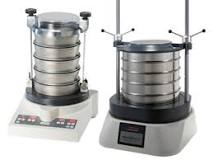
What is a Sieve Shaker?
A typical sieve shaker separates particles by passing them through a series of chambers with mesh filters and agitating the sample in order to obtain complete separation.
Depending on the equipment, there are options for sieving both solid and liquid samples
Sieve Shaker Suppliers In South Africa
R.S.E Sieve Shakers
MODELS:
SS200/300
SS450
APPLICATION:
Sieve shakers are designed to separate fine from coarse materials.
Standard sieve analysis is probably the fastest and most widely used quality control procedure due to its simplicity.
Particle size distribution is critical to the way the material performs in use.
Sieve shakers consist of a vibration mechanism housed in a base frame, enclosed with an upper free test sieve platform, clamp rods, and clamping lid.
Sieve shakers separate materials from 150mm to 25 microns.
Sieve shakers are used in the food, chemical, and mineral industries.
Sieve shakers are available in industrial heavy-duty units or laboratory bench-top model units.
TEST SIEVES:
A full range of test sieves are available as shown below.
Sizes 150mm diameter, 200mm diameter, 300mm diameter, and 450mm diameter
Wet sieving attachment available
What is a sieve shaker used for?
Sieve shakers are devices designed to help promote particle movement through a stack of sieves, facilitating accurate particle separation.
As the particles separate, they are retained on the various sieves depending on their size, providing insight into the average particle size of your sample.
How do you maintain a sieve shaker?
You can clean your sieves regularly with water after use. For particularly dirty sieves, you can clean your sieves with regular dish detergent and water. They should be allowed to dry thoroughly before the next use.
How long should sieve shaker be run for?
Select an initial test time, usually 3-5 minutes, and run a sieve analysis. Record the amount of sample retained (or passed, if that is the result typically recorded) on each sieve.
Using the same sieves and sample, run the test again incrementally longer, usually adding 1-5 minutes to the initial test time.
How long does ASTM say to shake the sieves?
Place an appropriate-size sample into the shaker being checked. Record the total weight of Sample (A). Set the timer for the required time (approximately 10-15 min.) to meet specifications (not more than 0.5% by weight of the total sample passes a given sieve in 1 minute).
